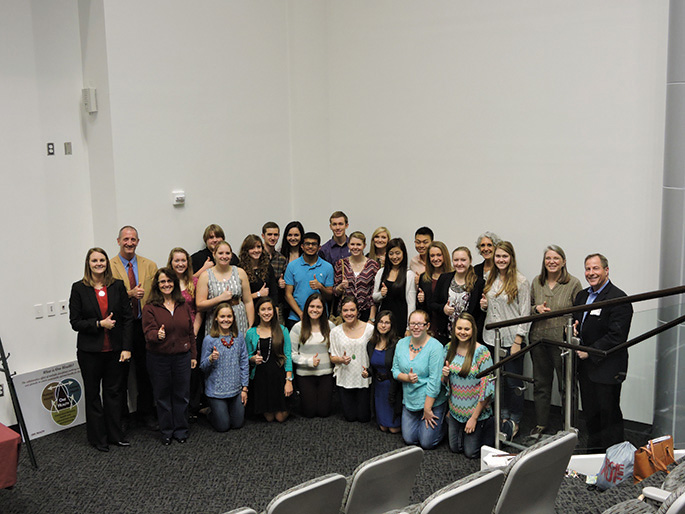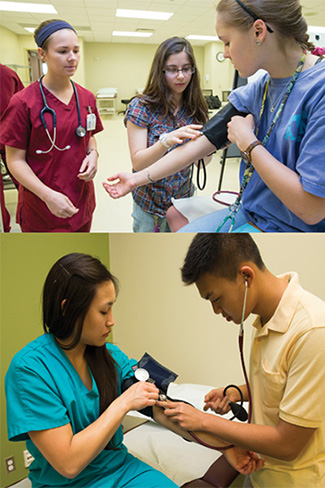One Health Learning Community Provides High-Impact Educational Opportunities
“It has shown me that everything influences health,” said Katelyn Franck, an animal science major at Texas A&M; University. She was talking about the One Health learning community, a non-credit course experience for first-year students majoring in any of a variety of fields. It introduces them to the concept of One Health: the collaborative effort of multiple disciplines working locally, nationally, and globally to attain sustainable optimal health for the ecosystem.

Holub, who earned a bachelor’s and master’s degree from Texas A&M;, was hired in part to develop educational programs in One Health, including the learning community. Students don’t pay or get academic credit for participating, but the course does appear on their transcripts.The goal of the One Health learning community is to “allow students to have the opportunity to see One Health in action,” said Merrideth Holub, the One Health program coordinator. This community, which is for college freshmen and occasional sophomores at Texas A&M;, is being offered for the third time. Since its inception, this community has hosted over 50 students. Lectures, field trips, and other activities show how humans, animals, and the environment are interdependent.
The learning experiences for the community cover a diverse array of topics illustrating One Health. These topics include antimicrobial resistance, zoonotic diseases, and architecture influencing health. Students visit the Clinical Learning Resource Center at the Texas A&M; Health Science Center to see the birthing station and participate in taking vital signs. They also talk with the Veterinary Emergency Team about field preparation and deployment. “These hands-on experiences help solidify relationships between the students,” said Dr. Christine Budke, associate professor in Veterinary Integrative Biosciences at the Texas A&M; College of Veterinary Medicine & Biomedical Sciences. “The students are inquisitive and engaged. It’s after normal class hours; they really want to be there.”
Students learn the importance of the environment through a variety of case studies. For example, in a neighborhood just east of downtown Austin, people can walk from their homes to destinations such as grocery stores, theaters, and shopping areas. Therefore, the design of the community helps to ensure residents incorporate exercise into their daily routines. The area is reclaimed from the site of the old Austin airport in a “sustainable, economically viable way,” said Dr. Xuemei Zhu, associate professor of architecture at Texas A&M.

The first event for spring 2015 was a panel of experts discussing antimicrobial resistance. Students dressed professionally because they were interacting with members of the panel. Ashley Vargas, a member of the learning community, said, “It was a little intimidating, but it was really neat to be exposed to that right off the bat.” Franck, another community member, said, “It was really cool to see professors enthusiastic and so into their work.”
Students from the learning community are challenged to “incorporate One Health throughout their education,” Holub said. Previous learning community members have said they plan to apply the principles of One Health in their careers. Melodie Raese, in the Texas A&M; Corps of Cadets, hopes to become a military veterinarian and take the One Health initiative with her when she accepts a commission.
Beyond the weekly meetings, community members are talking with one another and other students. Taylor states the students “have a willingness and excitement to talk to their cohort members and classmates about these issues outside the learning community.” Vargas said, “If I see a face I know then I’m like ‘Oh! Hi, I know you. You’re in my community.’ I can start conversations that way.”
Holub publicizes the learning community to students in a variety of ways. For example, the entire Texas A&M; first-year class is emailed about it. In addition, Holub speaks to introductory classes in architecture, biomedical sciences, environmental sciences, and geosciences. Both Holub and Dr. Matthew Taylor, associate professor of animal science and the faculty advisor for the One Health learning community, talk about the community in animal science courses.
The learning community is still growing and developing. Eventually, it may be offered to multiple groups of freshmen and sophomores. In addition, a more intense experience may be offered to juniors and seniors, including those previously in the learning community. “It would be a wonderful way to reconnect with the students and find out where they have gone,” Taylor said.
Students indicate that being in the One Health learning community has transformed their perspective about their career plans. For example, Franck said she has learned there are other ways to use a veterinary medicine degree besides clinical work. “Being in the learning community has really shown me different options that are out there.”


